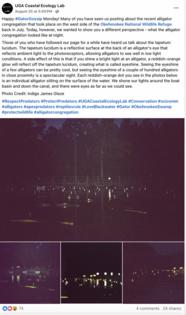Light focused on dark swamp revealed 'eyes as far as we could see,' research team says
Published in Science & Technology News
A scene straight out of a horror movie greeted researchers when they shined lights on a dark Georgia swamp and saw hundreds of red eyes staring back, photos show.
It happened at the Okefenokee Swamp, as the University of Georgia’s Coastal Ecology Lab was conducting an investigation.
“We shone our lights around the boat basin and down the canal, and there were eyes as far as we could see,” the lab wrote in an Aug. 25 Facebook post.
It was alligators, hundreds of them, and the team was witnessing a nighttime phenomenon known as eyeshine, experts say. The effect is rarely witnessed in mass numbers, the team noted.
“Tapetum lucidum is a reflective surface at the back of an alligator’s eye that reflects ambient light to the photoreceptors, allowing alligators to see well in low light conditions,” the lab wrote.
“A side effect of this is that if you shine a bright light at an alligator, a reddish-orange glow will reflect off the tapetum lucidum, creating what is called eyeshine. Seeing the eyeshine of a few alligators can be pretty cool, but seeing the eyeshine of a couple of hundred alligators in close proximity is a spectacular sight.”
Researchers visited the swamp after learning as many as 300 alligators had mysteriously gathered July 26 around a boat basin and canal in Stephen C. Foster State Park, lab officials said. The area is on the west side of the Okefenokee National Wildlife Refuge, which borders the Florida state line.
The congregation lasted about 24 hours, and experts have yet to understand why it happened.
It had nothing to do with mating or overpopulation. But the alligators could have been pursuing prey, or were possibly drawn to a more comfortable water temperature at the spot, lab officials said.
Males are typically territorial, which adds to the mystery of why so many crammed themselves in a small area, experts say.
Alligators are native to the Okefenokee Swamp, which consists of 353,981 acres that are protected as a national wildlife refuge. It is estimated about 15,000 alligators live in the murky water, according to the U.S. Fish & Wildlife Service.
©2025 Miami Herald. Visit at miamiherald.com. Distributed by Tribune Content Agency, LLC.










Comments